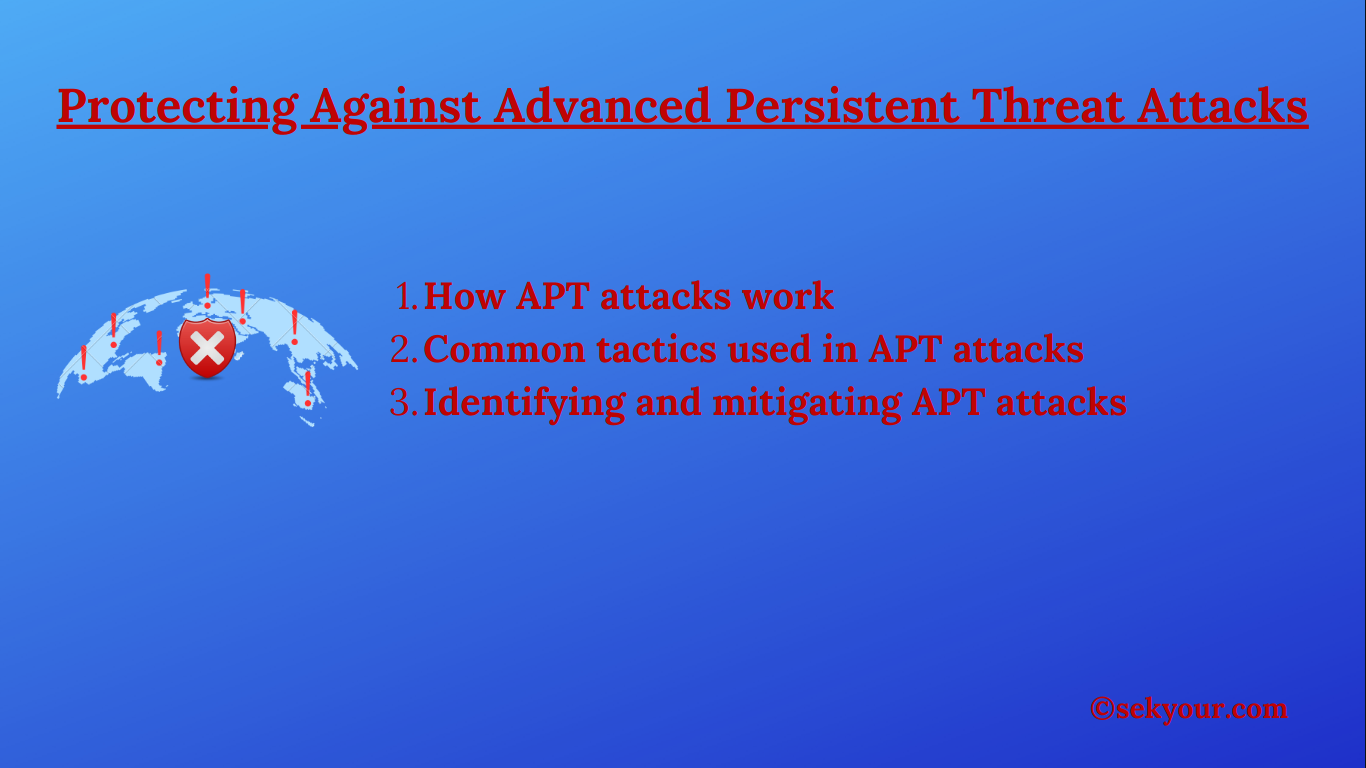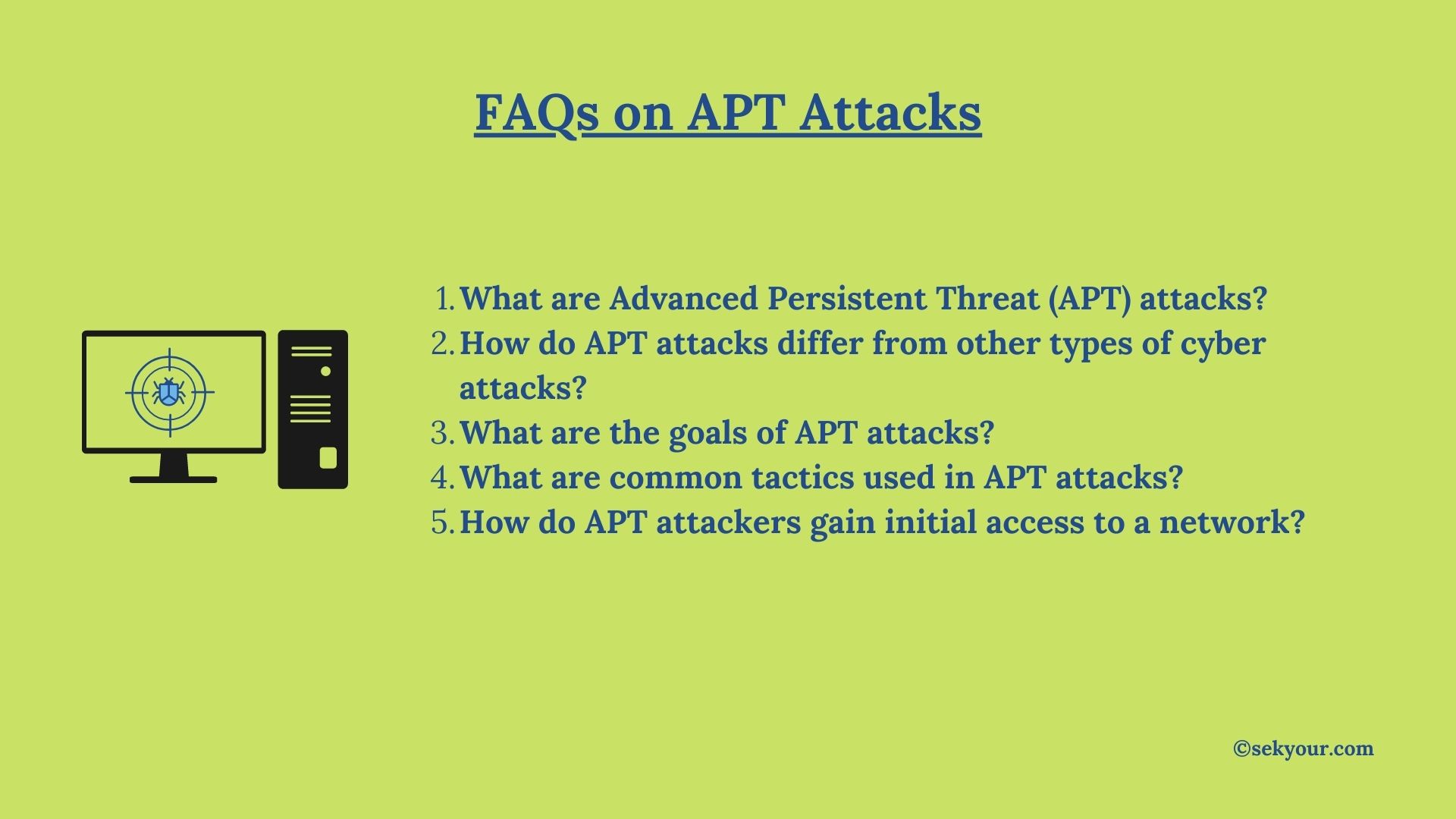1. Introduction
Advanced Persistent Threat (APT) attacks are a type of cyber attack in which an attacker establishes a long-term presence on a target’s network with the goal of stealing sensitive information or disrupting operations. These attacks are typically carried out by well-funded and well-organized groups, such as nation-state actors or criminal organizations.
APT attacks are considered to be a significant threat to organizations because of their ability to evade detection for long periods of time and the potential for significant damage to be inflicted on the target. Examples of APT attacks include the Aurora attacks on Google and other companies in 2010, the APT1 attacks on US companies and government agencies in 2011, and the Operation Aurora attacks on various companies in 2011.
To protect against APT attacks, organizations need to implement a comprehensive security strategy that includes both preventative measures and incident response capabilities. This may include implementing network segmentation, using multi-factor authentication, and regularly patching vulnerabilities. Additionally, organizations should have incident response plans in place, as well as the ability to detect and respond to APT attacks in a timely manner.
It is also important for organizations to stay informed about the latest APT attack techniques and threat actors, as well as to participate in information sharing and intelligence-gathering efforts. This can help organizations to better understand the threat landscape and to take proactive measures to protect against APT attacks.

2. How APT attacks work
Advanced Persistent Threat (APT) attacks are a type of cyber attack where an attacker establishes a long-term, undetected presence on a target’s network. The goal of an APT attack is often to steal sensitive data or disrupt operations, rather than causing immediate damage.
Initial intrusion and establishment of a foothold: The attacker uses various techniques such as phishing, malware, and exploiting vulnerabilities to gain initial access to the target’s network. Once inside, the attacker establishes a foothold by installing tools that allow them to maintain access and move laterally through the network.
Information gathering and reconnaissance: The attacker conducts reconnaissance to map out the target’s network and identify high-value assets. This information is used to plan and execute the next stages of the attack.
Establishing persistence and escalating privileges: The attacker establishes persistence by creating backdoors and other mechanisms that allow them to maintain access even if the target detects and removes the initial intrusion. They also escalate privileges by gaining access to higher-level accounts and systems, which gives them more control over the network.
Exfiltrating sensitive data: The attacker’s ultimate goal is often to steal sensitive data. They use various techniques such as data exfiltration tools, command and control (C&C) infrastructure, and data encryption to extract the data without detection.
One of the most famous APT attack is the APT1 group which is associated to the Chinese government. The group has been active since at least 2006 and has been linked to a number of high-profile cyber espionage incidents, including the theft of sensitive data from U.S. government agencies and private companies.
Another example is the APT29 group which is associated to the Russian government. The group has been active since at least 2008 and has been linked to a number of cyber espionage incidents, including the theft of sensitive data from U.S. government agencies and private companies.
Avoid plagiarism. Explain in technical depth. Write concise statements. Include incidents, interesting trivia, case study, real life examples if possible.
3. Common tactics used in APT attacks
Advanced Persistent Threat (APT) attacks are a type of cyber attack where an attacker establishes a long-term, undetected presence on a target’s network. The goal of an APT attack is often to steal sensitive data or disrupt operations, rather than causing immediate damage.
Social engineering and phishing: Social engineering is a tactic used by attackers to trick individuals into disclosing sensitive information or performing actions that compromise the security of a system. Phishing is a type of social engineering that uses email or other forms of communication to trick individuals into providing login credentials or other sensitive information. This is often the first step in an APT attack, as it allows the attacker to gain initial access to the target’s network.
Exploiting vulnerabilities in software and systems: APT attackers often seek out and exploit vulnerabilities in software and systems that are used by the target. These vulnerabilities may be present in software such as operating systems, web browsers, or other applications. By exploiting these vulnerabilities, the attacker can gain access to the target’s network and move laterally through it.
Using malware and other tools for remote control and command and control: APT attackers often use malware and other tools to remotely control and monitor the systems they have compromised. This allows the attacker to maintain access to the target’s network even if the target detects and removes the initial intrusion. Command and control (C&C) infrastructure is used to communicate with the malware and exfiltrate the stolen data.
4. Identifying and mitigating APT attacks
Advanced Persistent Threat (APT) attacks are a type of cyber attack that aims to establish a long-term, undetected presence on a target’s network. To protect against APT attacks, organizations need to implement a combination of technical and non-technical measures.
Importance of incident response planning and regular vulnerability assessments: Having a well-defined incident response plan in place is crucial for identifying and mitigating APT attacks. Additionally, regular vulnerability assessments can help identify and address potential weaknesses in an organization’s systems and networks before they can be exploited by attackers.
Utilizing threat intelligence and security tools to detect and block APT attacks: Utilizing threat intelligence can help identify potential APT attacks by providing information on the tactics, techniques, and procedures used by known APT groups. Security tools such as intrusion detection and prevention systems (IDPS), firewalls, and endpoint protection can help detect and block APT attacks as well.
Employee education and training on identifying and avoiding social engineering tactics: Social engineering is a common tactic used in APT attacks. Employee education and training on how to identify and avoid social engineering tactics can help protect an organization from falling victim to these types of attacks. Training should include the importance of being vigilant when receiving unsolicited emails, phone calls, or text messages, and not providing personal or sensitive information unless they are certain of the legitimacy of the request.
A real life example of this is the SolarWinds hack of 2020 where it’s been reported that the attackers used a phishing campaign to gain access to the company’s systems, and then used that access to insert malware into the company’s software updates. This allowed the attackers to gain access to the systems of SolarWinds' customers, which included government agencies and private companies. The incident highlights the importance of incident response planning, regular vulnerability assessments, and employee education and training in identifying and mitigating APT attacks.
5. Conclusion
Advanced Persistent Threat (APT) attacks are a type of cyber attack that aims to establish a long-term, undetected presence on a target’s network. These attacks are considered a serious threat to organizations of all sizes and industries as they can lead to the theft of sensitive data, disruption of operations, and long-term damage to an organization’s reputation.
To protect against APT attacks, organizations need to implement a combination of technical and non-technical measures. This includes incident response planning, regular vulnerability assessments, utilizing threat intelligence and security tools, and employee education and training on identifying and avoiding social engineering tactics.
In conclusion, APT attacks are a serious threat to organizations, and it’s important for organizations to understand how they work and take the necessary steps to mitigate them. Taking proactive measures such as implementing security protocols, regular vulnerability assessments, and employee education can greatly reduce the risk of an APT attack. Organizations should also be prepared to respond quickly and effectively in the event of an attack by having incident response plans and procedures in place.
6. FAQs on APT Attacks

1. What are Advanced Persistent Threat (APT) attacks?
APT attacks are a type of cyber attack where an attacker establishes a long-term, undetected presence on a target’s network. The goal of an APT attack is often to steal sensitive data or disrupt operations, rather than causing immediate damage.
2. How do APT attacks differ from other types of cyber attacks?
APT attacks differ from other types of cyber attacks in that they are focused on establishing a long-term, undetected presence on a target’s network. They are often used for cyber espionage, whereas other types of cyber attacks may be used for financial gain or causing damage.
3. What are the goals of APT attacks?
The goal of APT attacks is often to steal sensitive data or disrupt operations. APT attackers may also use the access they gain for future attacks or for use in espionage.
4. What are common tactics used in APT attacks?
Common tactics used in APT attacks include social engineering and phishing, exploiting vulnerabilities in software and systems, and using malware and other tools for remote control and command and control.
5. How do APT attackers gain initial access to a network?
APT attackers gain initial access to a network by using various techniques such as phishing, malware, and exploiting vulnerabilities. Once inside, the attacker establishes a foothold by installing tools that allow them to maintain access and move laterally through the network.